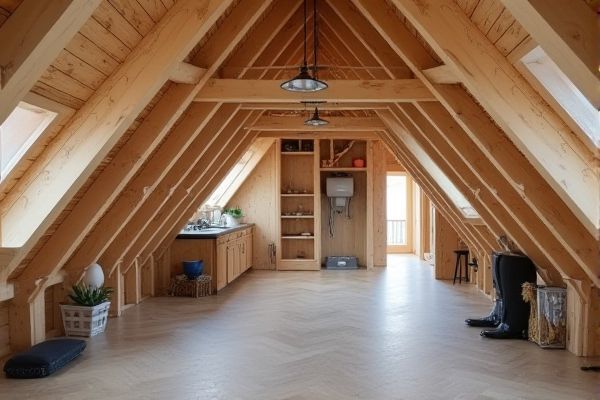
Under-eave storage maximizes low, often unused spaces beneath roof edges, offering easy access for frequently needed items, while vertical attic storage optimizes taller, open spaces for storing bulkier, less-accessed belongings. Discover which storage method suits your home organization needs best by exploring the differences in this article.
Table of Comparison
| Feature | Under-Eave Storage | Vertical Storage (Attic) |
|---|---|---|
| Location | Below roof eaves, typically in the overhang space | Inside attic space, above ceiling level |
| Storage Capacity | Limited, due to sloped roof and low clearance | High, utilizes full attic volume vertically |
| Accessibility | Easy to access without ladder, ground level | Requires ladder or attic stairs, less convenient |
| Climate Control | Often exposed to external temperatures, less stable | Better insulation, more stable temperature control possible |
| Security | Moderate, may be more exposed | Higher security, enclosed within the house structure |
| Usage | Ideal for seasonal items, garden tools, or infrequently accessed goods | Suitable for storing large volumes, household storage, or infrequently used items |
| Installation Cost | Lower, often part of house design | Higher, requires attic modifications and access installation |
Introduction to Under-Eave and Vertical Attic Storage
Under-eave storage utilizes the space directly beneath the roof's overhang, maximizing often overlooked low-clearance areas for organized storage of seasonal items and tools. Vertical attic storage exploits the height of an attic by installing shelving or vertical compartments, ideal for storing larger or bulky items while keeping your living spaces clutter-free. Choosing between under-eave and vertical attic storage depends on your home's architectural features and the types of items you need to store effectively.
Defining Under-Eave Storage
Under-eave storage refers to utilizing the space beneath the sloping edges of a roof, typically within the confines of a house's eaves, for organized storage solutions. This type of storage maximizes otherwise unused, low-height areas, ideal for seasonal items or infrequently accessed belongings. Unlike vertical attic storage that relies on full-height spaces, under-eave storage requires custom shelving or cabinets tailored to angled ceilings and limited headroom.
Understanding Vertical Attic Storage
Vertical attic storage maximizes space by utilizing the height of the attic, allowing for tall shelving units and stacked containers that optimize organization and accessibility. Unlike under-eave storage, which is limited by sloped ceilings and low clearance, vertical storage accommodates larger items and increases overall storage capacity. Effective vertical storage often includes sturdy shelving systems anchored to rafters, ensuring safety and stability within the attic environment.
Space Efficiency: Under-Eave vs Attic
Under-eave storage maximizes use of sloped roof spaces often overlooked, making it ideal for smaller items and seasonal decor, whereas attic vertical storage leverages full ceiling height for larger or bulky items. The attic allows for stacking and shelving options, enhancing space efficiency for heavier storage but may require reinforced flooring. Optimal storage choice depends on accessibility and item size, with under-eave suited for organized, compact arrangements and attics for extensive, high-capacity storage needs.
Accessibility and Convenience Comparison
Under-eave storage offers easier accessibility due to its lower and more open placement, making it convenient for frequently used items. Vertical attic storage maximizes space by utilizing the height, but it often requires ladders or climbing, reducing convenience for everyday access. Choosing between the two depends on balancing the need for quick reach against maximizing storage capacity.
Impact on Home Insulation and Energy Efficiency
Under-eave storage often interferes with attic insulation, compressing the material and reducing its effectiveness, which can lead to increased heat loss and higher energy bills. Vertical storage preserves attic insulation by keeping the insulation layer undisturbed, maintaining optimal thermal resistance and improving overall energy efficiency. By choosing vertical storage, you help maintain your home's insulation integrity, directly supporting lower energy consumption and improved temperature regulation.
Safety and Structural Considerations
Under-eave storage offers easier access but requires careful installation to avoid compromising roof integrity and to prevent moisture buildup that can lead to mold or structural damage. Vertical storage in attics demands ensuring the attic floor can support the weight of stored items without causing joist deformation or ceiling damage. Both options necessitate proper ventilation and adherence to building codes to maintain safety and structural soundness.
Ideal Uses for Under-Eave Storage
Under-eave storage is ideal for organizing frequently used outdoor tools, gardening supplies, and seasonal items due to its easy accessibility and protection from weather. It maximizes otherwise unused space beneath roof overhangs, perfect for compact storage solutions that keep clutter off the ground while maintaining quick access. Your outdoor maintenance routine becomes more efficient when utilizing under-eave spaces for items requiring regular reach and secure shelter.
Ideal Uses for Vertical Attic Storage
Vertical attic storage is ideal for maximizing space in homes with limited floor area, especially for storing seasonal items, holiday decorations, and rarely used belongings. This storage solution takes advantage of the height in attics, allowing for organized shelving units and bins that keep items accessible and protected from moisture. It is particularly beneficial for homeowners seeking to declutter main living spaces while preserving valuable items in a dry, out-of-sight location.
Which Storage Solution is Best for Your Home?
Under-eave storage maximizes space by utilizing the often-overlooked triangular areas beneath your roofline, ideal for smaller items and seasonal decorations, while vertical attic storage offers greater capacity and accessibility for larger belongings due to its taller, more open design. Choosing the best solution depends on your home's layout: under-eave storage suits homes with limited attic headroom, offering efficient compartmentalization, whereas vertical attic storage provides flexibility and ease of organization in homes with spacious attics. Consider your storage needs, available space, and how frequently you'll access stored items to determine whether compact under-eave compartments or expansive vertical attic systems will best enhance your home's functionality.
 homyna.com
homyna.com